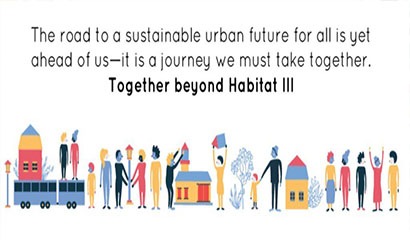


Habitat III was the United Nations Conference on Housing and Sustainable Urban Development. It took place in Quito, Ecuador, from the 17th to the 20th of October 2016.
In Resolution 66/207 and in line with the bi-decennial cycle (1976, 1996, and 2016), the United Nations General Assembly decided to convene the Habitat III Conference to reinvigorate the global commitment to sustainable urbanization, to focus on the implementation of a New Urban Agenda, building on the Habitat Agenda of Istanbul in 1996.
Member States of the General Assembly, in Resolution 67/216, decided that the objectives of the Conference were to secure renewed political commitment for sustainable urban development, assess accomplishments to date, address poverty, and identify and address new and emerging challenges. The conference resulted in the New urban Agenda—a concise, focused, forward-looking and action-oriented outcome document.
On 22 December 2015 the United Nations General Assembly, on its seventieth session, adopted the resolution on the ‘Implementation of the outcome of the United Nations Conference on Human Settlements (Habitat II) and strengthening of the United Nations Human Settlements Programme (UN-Habitat)’ (A/70/210) , which refers to the United Nations Conference on Housing and Sustainable Urban Development (Habitat III) Conference modalities. The approved rules of procedure for Habitat III recognises the participation of the representatives of local authorities accredited to the Conference in rule 64, as it happened in Habitat II in 1996.
The Conference welcomed the participation and contributions of all Member States and relevant stakeholders, including parliamentarians, civil society organizations, regional and local government and municipality representatives, professionals and researchers, academia, foundations, women and youth groups, trade unions, and the private sector, as well as organizations of the United Nations system and intergovernmental organizations.
Habitat III was the first United Nations global summit after the adoption of the 2030 Agenda for Sustainable Development and the Sustainable Development Goals. It offered a unique opportunity to discuss the important challenge of how cities, towns, and villages are planned and managed in order to fulfill their role as drivers of sustainable development and, hence, shape the implementation of new global development and climate change goals.